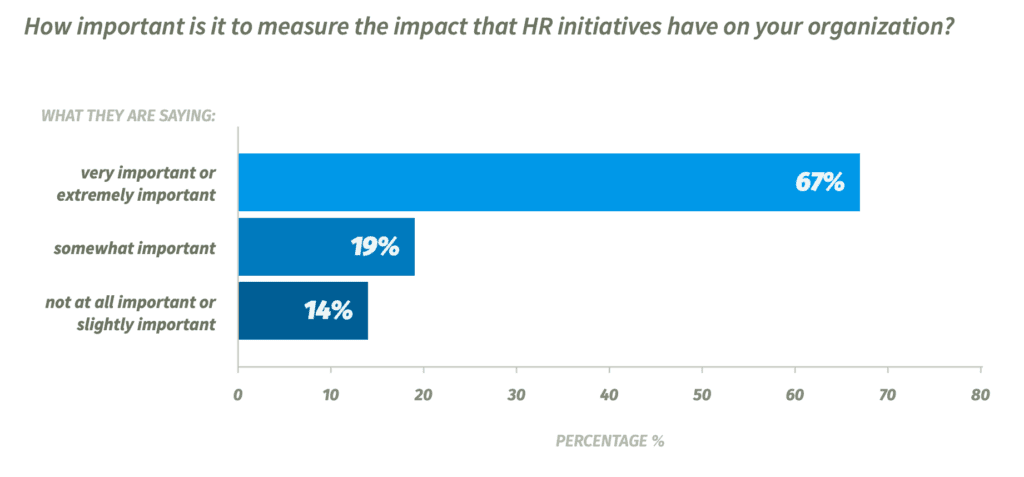Metrics are an essential component of HR Analytics and provide vital information for strategic decision-making. These primary HR measures give a fast summary of HR’s effectiveness and can be utilized as KPIs . The fact that many firms are beginning to employ HR Key performance metrics as a critical component of their entire business strategy is perhaps the most evident proof that workforce planning is gaining traction in business. Indeed, recent polls reveal that almost one-third of CEOs prefer to view HR team reports more frequently. Furthermore, 82 percent believe that such HR indicators are somewhat helpful or highly valuable for their firm.

If this is the case—if executives respect HR indicators and want to see more of the—HR departments must improve their data analysis skills. Not sure where to begin? This blog will help you understand the fundamentals of HR metrics and which ones you should be tracking to have a genuine influence on your business.
What are HR metrics?
HR metrics, also known as human resource metrics, are crucial data that assist firms in tracking their human capital and determining the effectiveness of their human resource activities. These are examples of such data:

- Turnover.
- Cost-per-hire.
- Benefits participation rate.
- Other metrics (we’ll go over more of them later).
Measuring this type of information—what works well, what needs improvement, and what trends to expect in the future—assists firms in determining their people strategy.
Why Are HR Metrics Important?
According to a recent survey, CEOs and HR experts believe that assessing HR and its influence on a business is vital. Many CEOs want to hear from their HR staff more frequently and with more extensive HR reports. This implies that HR metrics are no longer optional for any HR team looking to develop a sound, data-driven management approach for their firm.
HR Metrics Affect Your Strategy

In a poll, more than two-thirds of respondents responded that measuring the impact of HR initiatives on their business is very important or extremely important. This is a good indicator for human resource experts because, in the words of Peter Drucker, “what gets assessed gets improved.”
To expand on that statement, what is measured matters: 87 percent of respondents claimed that HR reports affect their organization’s strategy to varying degrees. If your business wants to make educated, strategic decisions in the future, it is evident that HR analytics must be a part of the jigsaw.
Executives desire HR Reports.
Despite the importance of HR reporting, it appears that some HR teams are not providing as much information as their executive teams would want. Almost one-third of the non-HR executives we polled stated their HR team doesn’t report frequently enough, and 16% said they have no clue how often their HR team reports.

While 51% of respondents agreed that their HR teams report regularly enough, the figures indicate that many firms still have room for improvement. HR has a fantastic opportunity here. Understanding your executive team’s reporting requirements and achieving those requirements will help you become a more strategic influence in your firm.
Now, look at different HR metrics likely to guarantee companies’ success.
What Are the Most Important HR Metrics?
We’ve developed a list of the most frequent metrics you should be aware of to assess your human resource initiatives’ performance, health, and efficacy. You may use these data to compare your company to others of a similar size and industry.
Absence rate
The unscheduled absence rate (absence days/FTE) is a vital HR indicator for measuring absenteeism. It keeps track of the percentage of missing employees throughout a specific period. This indicator also serves as a long-term benchmark: absence levels might vary monthly, but you want rates to remain generally low and constant over extended periods. Growing absence rates might suggest a deteriorating work environment, more significant workplace stress, or a flu outbreak. Average absenteeism rates range between 1 and 2%. (because almost everybody is ill a few days per year).
Absence rate per manager

HR may quickly identify trouble areas within the organization by dividing the number of absence days in a team or department by the total FTE (full-time equivalent) in this team or department. When particular divisions or managers struggle fundamentally with high absence levels, they may be doing something incorrectly, and their performance will suffer. This statistic can have a diagnostic and preventative role by allowing HR to intervene before problems escalate.
Overtime expense
People don’t mind working extra hours now and again. However, if overtime rate skyrockets, you may also expect your absence rates to skyrocket. Excessive overtime, particularly for extended periods (e.g., audit season for accounting companies), also contributes to turnover. Hiring more personnel can help to reduce consistently high amounts of overtime.

Employee Productivity Index
Employees have traditionally worked from 9 to 5, but an increasing number of individuals work from home. Companies are rapidly abandoning the old mindset. This means that performance can no longer be determined by who turns up.
It doesn’t matter how many hours you work in a day now. What matters is what you accomplished. A productivity index tracks this. Nonetheless, it raises the question of how productivity is defined. This will vary depending on the organization and role and must be carefully considered. We’ve written a comprehensive review of the 21 most important performance metrics you should be aware of.
Training expenses per employee
Training costs per employee are a standard measure. This statistic helps keep track of development expenditures. It also enables HR to make more informed investments in employee development. HR realizes that day-long training sessions are expensive and insufficient for offering employees a continual learning experience. Investing the available budget in continuous learning experiences will result in a more successful staff training programme.
Training effectiveness index

To assess the success of training, determine what people learnt. This isn’t easy. Comparing an employee’s performance before and after exercise is not enough. Most people apply for training when they believe they are failing. People who perform below their average for one month are likelier to achieve above average the next month. This is known as ‘regression to the mean.’ This would result in an imbalanced assessment of training efficacy.
When evaluating training efficacy, it is preferable to establish training objectives and then assess if employees met those objectives after the training. Companies can also measure baseline production and investigate the impact of training over time. Practical training is anticipated to help employees improve their jobs, raising their average performance. In other words, following practical training, the Employee Productivity Index should rise.
Healthcare Costs Per Employee

This indicator allows you to see how much of your budget goes toward employee health insurance expenditures. To determine your healthcare expenditures per employee, add your contributions to your workers’ healthcare premiums during a benefit period (e.g., one month) and divide by the number of covered employees.
Because healthcare prices continue to rise year after year, employees and employers are seeking methods to save money while providing excellent benefits to team members and their families. The first step in analyzing how your organization spends its resources is to track this expense.
Employee happiness
Employee happiness (also known as employee satisfaction) is becoming increasingly regarded as an essential HR statistic. Happy employees are productive employees because they are dedicated to the business and willing to work beyond hours when necessary. Employee satisfaction is linked to organizational commitment and work commitment. Employee dissatisfaction in specific sectors of the company might be a sign of conflict or job stress.
Voluntary turnover rate

When we discussed learning and growth, we highlighted turnover. Voluntary turnover is a crucial HR indicator for many businesses. Turnover is permanent; most individuals never return. People frequently quit their supervisors rather than their jobs. Keeping this in mind, turnover is another measure that may assist you in identifying possible trouble areas within the firm.
Talent turnover rate
Not all turnover is negative, however. People who do not fit in with the firm should instead depart. This is average turnover, but turnover becomes a significant issue when your key talent goes. This is why you should monitor the turnover of both your high and low potentials. Your high prospects should have a low turnover rate. A lack of career opportunities inside the organization is a significant reason for high turnover among high possibilities.

Retention rate per manager
Our manager metrics are fantastic. Some managers are exceptional at engaging and connecting with their people. Nonetheless, we all know managers who aren’t so great at it. Retention rates per manager or division are valuable for identifying unproductive managers. Once these managers have been identified, you may offer them additional assistance and teach them to become more successful managers.
New Hire Diversity & Inclusion
True diversity in your organization entails more than just improving employee team balance. It also entails having employees from diverse origins and identities at all levels of your business. This aim also entails a concerted effort to diversify your teams and management.

To track your KPIs and identify the diversity in your recruiting, split your entire business hires by a defined person group, then multiply by 100. It is expected that by 2024, over half of all employees in the United States will come from a diverse class.
Training Return on Investment
To compute this measure, you must evaluate total employee productivity using performance metrics. This indicator frequently incorporates metrics from your team’s sales success in a particular area or product line. This should also include an evaluation of client loyalty within a single product or service line or throughout the entire firm (also known as your net promoter scores) (NPS). If the cost of staff training equals the value of improved performance, your percentage would be 100%. This implies you repaid the entire amount of your investment. As a general guideline, you want your ROI to be more than 100%.
Conclusion
The job you do in human resources is critical to your firm’s success. However, without monitoring and tracking the key HR indicators, it can be impossible to determine if your work is making a difference or how you might enhance your efforts.
If you aren’t currently measuring any human resources metrics, meet with your executive and HR teams to determine which data you should start tracking immediately. Keep it basic; there’s no need to run hundreds of reports directly. If you are currently monitoring HR indicators, double-check that all of your data is assisting your firm in meeting its objectives.




